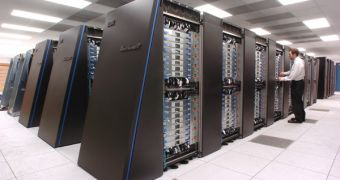Despite the many apocalyptic ideas and films that arose from the idea of machines capable of human-like reasoning, humanity is still doing its best to create a computer capable of thinking for itself. Despite the fact that a self-conscious machinery is not even remotely feasible (yet) with our current level of technology, IBM, determined to at least make an ant-sized step forward, decided to go with something far less complicated than the human brain: a cat's brain.
"We've made tremendous advances in collecting data, but we don't have a collective theory yet for how this complex organ called the brain produces things like Shakespeare's sonnets and Mozart's symphonies," Jim Olds, a neuroscientist and director of the Krasnow Institute for Advanced Study at George Mason University, said. "The holy grail for neuroscientists is to map activity from single nerve cells, which they know about, into how billions of nerve cells act in concert."
The simulation only included the cerebral activity of the feline cortex, so not really the whole brain, only the part that scientists considered to be responsible for the act of thinking itself. The program that the interdisciplinary researchers used to enact the simulation, their massively parallel cortical simulator, was revealed at the Supercomputing 2009 to have reached a stage where it could simulate 4.5% of a human brain's functions, which are more complicated than the total capabilities of a cat.
Thankfully, this time around, it wasn't about just how many terabytes of information the brain itself could hold at one time. Instead, the researchers looked at the amount of neurons and synapses, managing to create a working model that simulated real-world neural interactions, with the neurons organized similarly to those in a mammalian cortex. The people working on this hit a snag, though, in that, when the simulation gained a certain level of fidelity to a real brain, it became just as hard to figure out as the real thing.
"When combined with the mammalian-scale models now possible with C2, the flood of data can be overwhelming from a computational (for example, the total amount of data can be many terabytes) and human perspective (the visualization of the data can be too large or too detailed)" section 3.2.2 of the paper says, when it describes a measurement tool researchers call the "BrainCam."
In order to just barely manage this feline-brain simulation, the team used the Dawn Blue Gene /P supercomputer. The supercomputer is located in the Lawrence Livermore National Laboratory and employs 147,456 processors (compared with the one or two used by normal PCs) and can store up to 144 terabytes of data. By employing a program that told the system to behave like a brain would, the most that could be accomplished was a simulation running 100 times slower than a real cat cortex.
Previous attempts at a brain-activity simulation include 40 percent of a mouse's brain in 2006, a rat's brain in 2007 and, earlier this year, one percent of a human's cerebral cortex. This was accomplished by using each time a bigger supercomputer. Considering this, it is quite obvious that the age of self-conscious walking drones is nowhere near our time or remotely viable as a concept with only our current knowledge.

 14 DAY TRIAL //
14 DAY TRIAL //